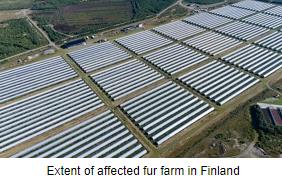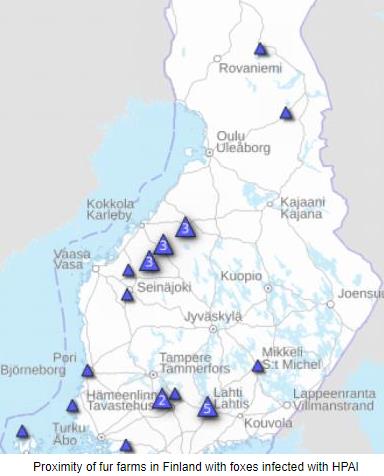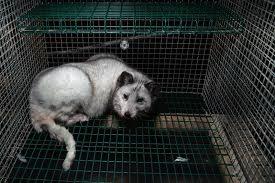Following an initial isolation of H5N1 HPAI virus from foxes in a fur farm in Ostrobothnia, Finland, surveillance has identified infection on an additional 25 farms located in close proximity in the Kausti locality. Approximately 120,000 foxes have been euthanized on ten farms with depopulation proceeding at an additional three facilities. The molecular characteristics of the virus from foxes is common to the isolates from sea gulls in the area. The Food Authority of Finland is closely monitoring the infection in farms raising foxes and other species for the fur trade.

Concentration of fur-bearing animals including mink, represent a potential for mutation of the H5N1 virus to become zoonotic. For a clade 2.3.4.4b avian influenza virus to become pathogenic to humans, a number of mutations are required. It is presumed that the first of these involving the PB2 gene coding for polymerase activity has occurred. The E627K mutation involving substitution of glutamate for lysine is necessary for the avian virus to reproduce in mammalian cells. Amino acid substitutions associated with mutations Q226L and G228S in hemagglutinin are also required to allow an H5N1 avian virus to attach to mammalian host cells.
It is unlikely that the two mutations could occur simultaneously in nature although concentration of a susceptible species such as mink or foxes in close proximity would exert selection pressure leading to a virus that could be pathogenic in humans and also be sufficiently stable for airborne transmission. A further mutation that would favor pathogenicity would be a genetic change to allow the virus to evade an intracellular protein termed MxA that activates the immune system against an influenza virus.
 Through increasing knowledge of the molecular virology of influenza viruses and the immunology of infections, it is evident that H5N1 is currently not pathogenic to humans. This is evidenced by the low number of cases diagnosed with H5N1 infection despite extensive exposure. The possibility of sequential mutations occurring in H5N1 in large populations of birds such as a farm with two to five million hens or in mammalian populations on fur-production farms increases the opportunity for mutation.
Through increasing knowledge of the molecular virology of influenza viruses and the immunology of infections, it is evident that H5N1 is currently not pathogenic to humans. This is evidenced by the low number of cases diagnosed with H5N1 infection despite extensive exposure. The possibility of sequential mutations occurring in H5N1 in large populations of birds such as a farm with two to five million hens or in mammalian populations on fur-production farms increases the opportunity for mutation.
The risk of a recombinant event with an individual infected with a human strain of influenza coming into contact with an infected flock or herd could theoretically occur and might lead to a novel zoonotic strain. Accordingly, all personnel coming into contact with flocks of poultry or concentrations of fur-bearing animals should be immunized against circulating strains of human influenza.

Farms housing mink, foxes and other fur-bearing animals represent a potential danger to human populations. Production of pelts is intended to satisfy vanity and serves no practical purpose while representing a potential risk to humanity. Fur production should be phased out in the U.S. as has occurred in many nations in Europe. This does, however, not obviate risk since the demand for pelts persists with a shift in production to nations including China, the primary source of zoonotic viral pathogens with pandemic potential.